High pH, low nutrient fluids from the deep biosphere
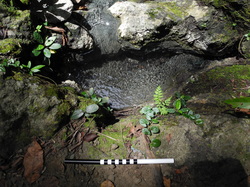
Microbial communities inhabiting the Earth’s subsurface occupy a scientifically uncharted realm, and may penetrate the Earth’s crust to depths of 5 to 10 km--until it is too hot to survive. It has been estimated recently that the deep subsurface habitat could accommodate more biomass and biodiversity than on Earth’s surface, and the impact of this vast reservoir of biomass on biogeochemical cycling on Earth is a gaping hole in our current knowledge of Earth systems. We tackle these questions by investigating how life transforms water and rock in high pH springs that are sourced in systems undergoing present or past serpentinization. The serpentinization process often occurs in areas where ancient marine rocks interact with water, producing highly reduced fluids of high pH. These fluids are typically low-nutrient, and yet host specialized microbial ecosystems. Our two main field locations are in the ophiolite region in Turkey, and the Zambales and Palawan ophiolites in the Philippines. Studying these deeply-sourced springs allow us to learn more about critical chemical and biological connections in ways that may serve both science (particularly in defining the unknown edge of the biosphere in these exciting settings—including how microbes survive in low oxygen, low nutrient settings) and society (with strong links to ongoing experiments in carbon sequestration, toxic waste storage, bioremediation of mining wastes, and micro-scale medical applications). Both projects include characterization of microbial communities, nitrogen and carbon cycling investigations, geochemical analyses of the fluids, and attempts at culturing microorganisms to better understand ecosystem function. Our project in Turkey was funded primarily through student funding to graduate student Kristin Woycheese by the Illinois Space Grant Consortium, and also by the Faculty Scholarship Support Program at UIC. The Philippines project was funded by NSF (EAR 1147334) - click this link to go directly to the Geobiology of high pH springs in the Philippines webpage!. For additional information about research concerning life in the deep biosphere, check out our Collaborators' work.
Astrobiology in putative ecosystems on Titan
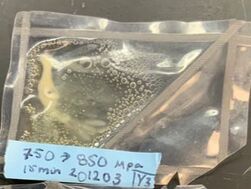
Saturn's moon, Titan, is an exciting focus for the Astrobiology community, featuring a global, subsurface ocean, and a global icy crust with plentiful organic compounds that might serve as potential building blocks of ice or metabolic sources of energy or carbon. Conditions on Titan are harsh, however, with the temperatures in the ocean expected to be between -15 to 10C, and pressures that are between 150-750MPa. Our lab, with UIC collaborator Fabien Kenig, has developed a high pressure culturing chamber that allows us to test the ability of Earth organisms to survive and thrive under Titan like conditions. Using two model Bacteria (with more to come), Shewanella oneidensis and Staphylococcus warneri, we are experimenting with pressures up to 750MPa, to see how the organisms respond and if they produce biomarkers that are unique to high pressure, cold conditions. Our design allows high volumes of cell culture to be used, which allows enough material for a myriad of downstream analyses such as quantification of biomass, profiling of lipid biomarkers, and observations of changes to the transcriptome of the test organisms. This work is in collaboration with JPL, and is funded by NASA's NAI program (CAN8). Click HERE to learn more about this NAI, and the many people involved in the broader project.
Microbiology of municipal solid waste landfill soils
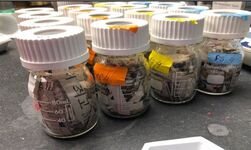
Municipal solid waste (MSW) landfills are manmade ecosystems that have many of the same characteristics of the deep biosphere, featuring anaerobic soils that may be low pH, and are often >100m deep. In addition, some landfills operate at higher temperatures than normal, causing cessation of the microbial processes that are responsible for the degradation of organic waste. Our project explores the impact of ecosystem stressors on microbial populations in both simulated and environmental landfill soils. High temperatures in landfill soils occur in a small percentage of MSW landfills, and the causes are largely unknown. In addition, the content of the waste stream changes over time, and modern waste streams contain components that could negatively impact the soil microcosm. For example, modern waste contains high percentages of construction and demolition waste, microplastics, and antibiotics. These components can enhance Bacteria that compete with methanogenic Archaea responsible for the final decomposition of landfill waste, or suppress Bacteria that produce the acetic acid, CO2, and H2 that fuel methanogenesis. We experiment using microcosms to test addition of modern waste stream components in controlled settings, and explore microbial communities of landfill ecosystems.
Microbiome diversity and functions in native Illinois soils
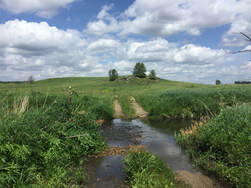
We have two major projects in the Nachusa Grasslands, a site which hosts prairie, wetland, and forested biomes. The first project investigates the impact of microplastics (MPs) on soils from these biomes, and searches for MPs present in the preserve's soils. Using microcosm experiments, MPs are introduced to the soils. We investigate the impact of MPs on the microbial communities, and look for MP degrading microbes. The second project is in collaboration with Gavin McNicol (project PI), and will quantify soil carbon concentrations and stocks, and greenhouse gas emissions of carbon dioxide, methane, and nitrous oxide in addition to co-registering microbial community composition with the same soils. These data will provide the first data looking at greenhouse gas emissions from soils in Nachusa ecosystems, and the role these soils play in climate regulation. These new projects are in progress - see our 'lab members' tab to see student involvement and come back soon for new information!
Nitrogen and carbon cycling in hydrothermal ecosystems
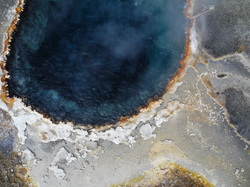
The availability of "fixed" nitrogen limits productivity in any ecosystem, and in particular oligotrophic (nutrient limited) ecosystems. While much of N-cycle research focuses on eutrophic agricultural soils and oligotrophic open ocean, interest in N-cycling in other oligotrophic ecosystems, such as the deep biosphere and “extreme” ecosystems is increasing. “Extreme” hydrothermal ecosystems are directly relevant to global N-cycling, representing probable origins of N-cycling on early Earth, and having significant impact on the modern N-budget (e.g. N2O production in hydrothermal systems, Hedlund et al., 2011). Likewise, carbon fixation in hydrothermal systems may play a key role in the carbon cycling of the larger ecosystems they reside within. The EDGElab is working on several fronts to understand both carbon and nitrogen cycling in hydrothermal ecosystems, in locations in Yellowstone, Turkey, Italy, and the Philippines. We employ culturing techniques to capture members of these microbial communities who are capable of nitrogen cycling. We also extract nucleic acids (DNA and RNA) from hydrothermal fluids, sediments, and biofilms, and then search for functional genes related to carbon and nitrogen cycling. Once isolated, DNA and RNA can tell us if these genes are present in the ecosystems, "who" the genes belong to, and whether or not the genes were being used by the microorganisms when the samples were taken. Measurements of carbon and nitrogen isotopes in the fluids, sediments, and biofilms can also inform us about how carbon and nitrogen are moved through the ecosystems. Work in Turkey and Yellowstone has been funded in in the past by NASA (via the NASA Astrobiology Program and Illinois Space Grant Consortium), work in the Philippines was funded by the National Science Foundation (EAR 1147334). Check out the students working on these projects on our lab members link!
Biogeography & diversity in "extreme" environments
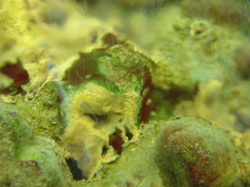
For the past several decades, a lot of attention has been given to exploring various "extreme" environments on Earth and making a census of the microorganisms that live in them. These are activities that EDGElab members are adding to, with every project that we initiate. Beyond cataloguing microbial diversity in our field locations, we are more interested in thinking about how those organisms are related to each other, how they're distributed within a single site, across multiple sites, and across the Earth. We are working to bring broad concepts of macroecology into our investigations of community diversity and structure, on both small and large scales. For example, past student Katie Walther looked at differences in microbial diversity in a single hot spring on a scale of a 5cm grid, and several meters down the spring's outflow channel. She then compared these results to similar hot spring systems in multiple thermal basins. Previous work by Meyer-Dombard and colleagues has investigated relationships of organisms and ecological function with distance down a single outflow channel. Together with colleagues, we are also investigating the affect that changing environmental conditions have on microbial diversity and dynamics in hydrothermal systems. Future work will employ statistical methods and ecological indices to relate basin-wide differences with geochemical parameters. These investigations will inform our efforts to understand how ecological rubric fits into the study of ecosystems on a micro scale.
Culturing of "extremophiles"
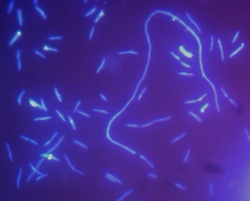
Investigating microorganisms that live in "extreme" environments, like hot springs, glacial ice, desert endoliths, extreme pH, high salt, high UV, or high contaminant levels, can be very challenging. Direct investigations using nucleic acid-based approaches can catalog the diversity in these environments and allow us to identify ecological and cellular functions. But for some questions, it's necessary to culture live organisms to get to an answer. For example, with culturing we are able to answer questions about the ideal growth conditions (temperature, pH, salt content, growth rate, etc.) for a specific "extremophile." Culturing also allow us to directly investigate processes such as metabolic rates, and can provide direct evidence of biogeochemical cycling. The EDGElab is equipped to culture organisms from a broad range of "extreme" environments. We are tackling organisms that live in terrestrial hydrothermal systems, and organisms that live in high pH (serpentinizing) systems, as well as those inhabiting the man-made 'deep biosphere' ecosystem found in landfill environments. These include both aerobic and anaerobic chemotrophic organisms. These projects were led by past graduate students Caitlin Casar and Bharathi Vallalar, current students Judy Malas, Sarah Khoury, and Michael Tanzillo, as well as several of our current EDGElab undergraduate researchers.
Preservation of biomarkers in natural settings
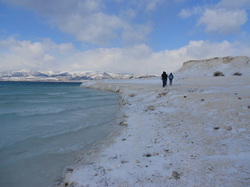
Biomineralization (precipitation of minerals by organisms) is a new focus of the EDGElab group. Together with collaborators we have worked to characterize microbialites from a variety of lacustrine environments. Primarily, we are interested in how climate and geochemistry of lakes may affect the formation rate, morphology, and diversity of microorganisms of microbialites. This has direct relevance to the preservation potential of "biomarkers" and biofossils in our rock record, and can inform us about conditions on early Earth. We are also interested in chemical biomarkers such as isotopic signatures that record carbon and nitrogen cycling processes. Additional work investigated the taphonomy of biomarkers in cave ecosystems.
Seafloor processes near hydrothermal sources
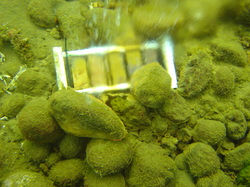
Marine hydrothermal systems include the deep marine black smoker chimneys as well as the lesser-known shallow marine hydrothermal vents. Past work by D'Arcy Meyer-Dombard has included investigations of arsenic and iron cycling near shallow-marine vent locations in Papua New Guinea, and undergraduates in the EDGElab are working on samples from shallow-marine vents in Italy to investigate nitrogen cycling. Future work will include similar studies in other shallow marine hydrothermal sites.
This page updated....updates in progress May 2024...
